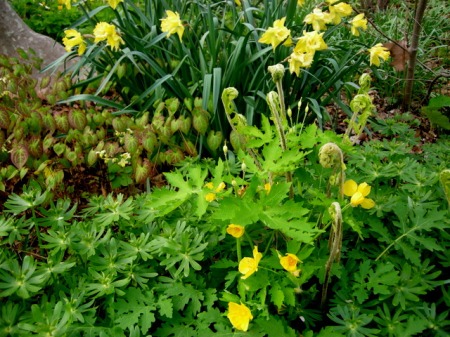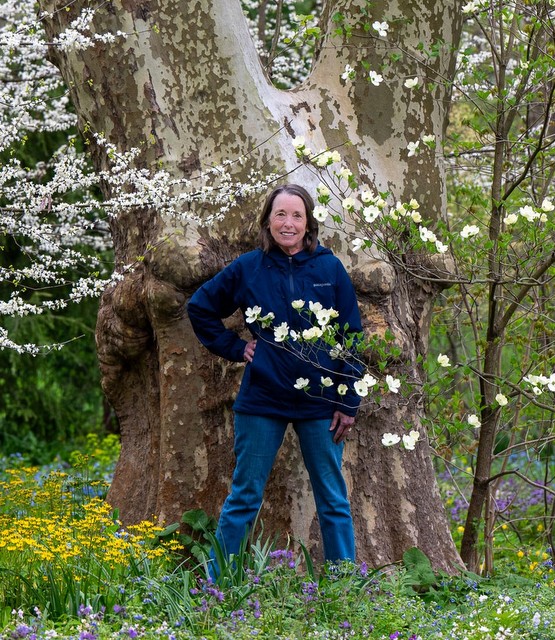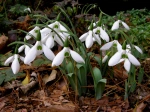 The cover of The Garden Tourist by Jana Milbocker features the teacup garden at Chanticleer in Wayne, Pennsylvania, one of my favorite gardens.
The cover of The Garden Tourist by Jana Milbocker features the teacup garden at Chanticleer in Wayne, Pennsylvania, one of my favorite gardens.
Nursery News: Carolyn’s Shade Gardens is a retail nursery located in Bryn Mawr, PA, specializing in showy, colorful, and unusual plants for shade. The only plants that we ship are snowdrops within the US. For catalogues and announcements of local events, please send your full name, mailing address, and cell number to carolyn@carolynsshadegardens.com and indicate whether you are interested in snowdrops, hellebores, and/or hostas. Click here to get to the home page of our website for catalogues and information about our nursery and to subscribe to our blog..
Carolyn’s Shade Gardens has been selected as one of the 120 must visit destination gardens and nurseries in the Northeast United States in the wonderful guidebook The Garden Tourist by Jana Milbocker. This book is a great resource for those of us who love to visit gardens as it covers Maine through Pennsylvania with detailed information on each entry, including photos, suggested daily itineraries, and nearby restaurants. You can purchase The Garden Tourist on Amazon here, or at Valley Forge Flowers in Wayne, Pennsylvania, if you are local.
I have visited, photographed, and written about many of the destinations included in the book, so, from personal experience, I can say that they are well-chosen. As a sample, here are the featured Pennsylvania gardens and nurseries: Ambler Arboretum, Bartram’s Garden, Carolyn’s Shade Gardens, Chanticleer, Highlands Mansion & Garden, Hortulus Farm Garden & Nursery, Longwood Gardens, Meadowbrook Farm, Shofuso Japanese Garden, Scott Arboretum, Terrain, and Wyck Garden.
Nursery News: Carolyn’s Shade Gardens is a retail nursery located in Bryn Mawr, PA, specializing in showy, colorful, and unusual plants for shade. The only plants that we ship are snowdrops to US customers only. For catalogues and announcements of events, please send your full name, mailing address, and cell number to carolyn@carolynsshadegardens.com. Click here to get to the home page of our website for catalogues and information about our nursery and to subscribe to our blog.
 The Carolyn’s Shade Gardens page from The Garden Tourist.
The Carolyn’s Shade Gardens page from The Garden Tourist.
We are so honored to be included in this wonderful garden resource. Many of our customers have already purchased it and are looking forward to putting it to use. One longtime customer even brought his copy over so I could autograph the Carolyn’s Shade Gardens page! I thought it would be fun to give my readers, especially my international followers, a more in depth photographic tour of Carolyn’s Shade Gardens. The photographs used in this post were taken from 2010 to 2019. Enjoy!
.
 Stone stairs lead from the nursery area, past the original entrance to the two-room gardener’s cottage that is now our home, to the Main Terrace. All the areas of our garden have names, which I will capitalize. That way my husband Michael and I can communicate about garden maintenance. During our last open house, visitors were overheard referring to “the team of workers who [must] take care of the gardens.” We are still laughing and wondering when our team will arrive! Michael does most of the maintenance, and I help when I can. 5/7/2012
Stone stairs lead from the nursery area, past the original entrance to the two-room gardener’s cottage that is now our home, to the Main Terrace. All the areas of our garden have names, which I will capitalize. That way my husband Michael and I can communicate about garden maintenance. During our last open house, visitors were overheard referring to “the team of workers who [must] take care of the gardens.” We are still laughing and wondering when our team will arrive! Michael does most of the maintenance, and I help when I can. 5/7/2012
.
 On the way down the stairs, you pass the entrance to the Main Rock Garden. It is mostly a winter garden filled with snowdrops, snowflakes, hardy cyclamen, winter aconite, and other early bulbs. 4/25/2016
On the way down the stairs, you pass the entrance to the Main Rock Garden. It is mostly a winter garden filled with snowdrops, snowflakes, hardy cyclamen, winter aconite, and other early bulbs. 4/25/2016
.
 The Main Terrace outside the front door in early spring. 4/15/2012
The Main Terrace outside the front door in early spring. 4/15/2012
.
 The Main Terrace a month later. 5/15/2015
The Main Terrace a month later. 5/15/2015
.
 Michael’s pride and joy and a major feature of the Main Terrace is our gorgeous wisteria. Plein Air painters come to capture it on canvas every year. 4/29/2011
Michael’s pride and joy and a major feature of the Main Terrace is our gorgeous wisteria. Plein Air painters come to capture it on canvas every year. 4/29/2011
.
 One of my favorite color combinations on the Main Terrace: ‘Magic Carpet’ spiraea, ‘Gold Heart’ bleeding-heart, and Spanish bluebells emerging from a silver-variegated ornamental grass. 4/15/2012
One of my favorite color combinations on the Main Terrace: ‘Magic Carpet’ spiraea, ‘Gold Heart’ bleeding-heart, and Spanish bluebells emerging from a silver-variegated ornamental grass. 4/15/2012
.
 We call the lowest of our three terraces the Orange and Purple Garden. Here ‘Paliban’ lilac blooms over a collection of small hostas with orange geum in the foreground. 5/10/2015
We call the lowest of our three terraces the Orange and Purple Garden. Here ‘Paliban’ lilac blooms over a collection of small hostas with orange geum in the foreground. 5/10/2015
.
 The Orange and Purple Garden features a grass oval surrounded by stepping stones inter-planted with sedums, geums, thyme, moss phlox and other low plants. 5/8/2011
The Orange and Purple Garden features a grass oval surrounded by stepping stones inter-planted with sedums, geums, thyme, moss phlox and other low plants. 5/8/2011
.
 The Orange and Purple Garden in fall when our coral bark maple ‘Sango-kaku’ is the star of the show. 11/2/2013
The Orange and Purple Garden in fall when our coral bark maple ‘Sango-kaku’ is the star of the show. 11/2/2013
.
 in front of the terraces in the lawn area is a very old American hornbeam with lots of surface roots and a dense canopy requiring plants that can handle full dry shade. The Hornbeam Garden features Japanese woodland primroses (in flower above), Athyrium-type ferns (Japanese painted, lady, and ‘Ghost’ ferns), hellebores, cardamine, golden groundsel, and pulmonarias, among other plants. 4/15/2012
in front of the terraces in the lawn area is a very old American hornbeam with lots of surface roots and a dense canopy requiring plants that can handle full dry shade. The Hornbeam Garden features Japanese woodland primroses (in flower above), Athyrium-type ferns (Japanese painted, lady, and ‘Ghost’ ferns), hellebores, cardamine, golden groundsel, and pulmonarias, among other plants. 4/15/2012
.
The Chain Link Strip Garden (don’t ask) along the right boundary of our property is a great place to grow hostas because all the water from the driveway drains through here—hostas love water. Blue-leafed ‘Neptune’ is on the left, and 2007 Hosta of the Year ‘Paradigm’ is on the right behind a native Carolina allspice. ‘Paradigm’ measures 60″ wide. 6/7/2019
.
 Native ‘Golden Shadows’ pagoda dogwood is dwarfed by this ‘Great Expectations’ hosta in the Chain Link Strip Garden. Hosta experts tell me it is the biggest specimen they have ever seen at 52″ wide. 6/7/2019
Native ‘Golden Shadows’ pagoda dogwood is dwarfed by this ‘Great Expectations’ hosta in the Chain Link Strip Garden. Hosta experts tell me it is the biggest specimen they have ever seen at 52″ wide. 6/7/2019
.
 All the way at the bottom of the yard where it is actually consistently moist are our Production Beds where we grow shade plants to sell at Carolyn’s Shade Gardens. Pictured are ‘Old Brick Reds’ primroses, two types of pulmonaria, and golden groundsel. 5/10/2015
All the way at the bottom of the yard where it is actually consistently moist are our Production Beds where we grow shade plants to sell at Carolyn’s Shade Gardens. Pictured are ‘Old Brick Reds’ primroses, two types of pulmonaria, and golden groundsel. 5/10/2015
.
 Walking back uphill towards the woodland, you pass our River of Phlox ‘Sherwood Purple’. Native, evergreen creeping phlox makes an excellent groundcover with gorgeous purple, blue, pink or white flowers, depending on which cultivar you plant. In the River, we have planted a large part of our snowdrop collection, which blooms December through March before the phlox flowers extend. 4/24/2019
Walking back uphill towards the woodland, you pass our River of Phlox ‘Sherwood Purple’. Native, evergreen creeping phlox makes an excellent groundcover with gorgeous purple, blue, pink or white flowers, depending on which cultivar you plant. In the River, we have planted a large part of our snowdrop collection, which blooms December through March before the phlox flowers extend. 4/24/2019
.
 In late winter, snowdrops and winter aconite begin to emerge along the woodland path. 3/2/2019
In late winter, snowdrops and winter aconite begin to emerge along the woodland path. 3/2/2019
.
 The snowdrops have been multiplying here for over 100 years and fill the Woodland with white when they open. 3/26/2015
The snowdrops have been multiplying here for over 100 years and fill the Woodland with white when they open. 3/26/2015
.
 When the snowdrops and aconite are done, the Woodland bursts into bloom with mostly native wildflowers—the native, white redbud trees play a starring role. 4/15/2019
When the snowdrops and aconite are done, the Woodland bursts into bloom with mostly native wildflowers—the native, white redbud trees play a starring role. 4/15/2019
.
 Plants native to Pennsylvania fill the Woodland, here mayapples, golden groundsel, and Virginia bluebells. 4/25/2017
Plants native to Pennsylvania fill the Woodland, here mayapples, golden groundsel, and Virginia bluebells. 4/25/2017
.
 Epimediums, daffodils, cinnamon ferns, and Celandine poppies replace the February-blooming aconite whose leaves are still visible at their base. 4/26/2015
Epimediums, daffodils, cinnamon ferns, and Celandine poppies replace the February-blooming aconite whose leaves are still visible at their base. 4/26/2015
.
 Natives dwarf Jacob’s ladder, black cohosh, and foamflower line the path. 5/10/2015
Natives dwarf Jacob’s ladder, black cohosh, and foamflower line the path. 5/10/2015
.
 The Lower Deck Garden provides early color from hellebores, ‘Mohawk’ viburnum, pink old-fashioned bleeding-hearts, and the rose-colored new leaves of ‘Butterfly’ Japanese maple. 4/26/2015
The Lower Deck Garden provides early color from hellebores, ‘Mohawk’ viburnum, pink old-fashioned bleeding-hearts, and the rose-colored new leaves of ‘Butterfly’ Japanese maple. 4/26/2015
.
 The Upper Deck Garden comes into its own later in May with Hosta nigrescens, pulmonaria, Spanish bluebells, and variegated Solomon’s seal, all echoing the blue and silver garden under the Kentucky coffee tree across the path. ‘Butterfly’ has assumed its main season color of green and white but will turn pink again in the fall. 5/6/2011
The Upper Deck Garden comes into its own later in May with Hosta nigrescens, pulmonaria, Spanish bluebells, and variegated Solomon’s seal, all echoing the blue and silver garden under the Kentucky coffee tree across the path. ‘Butterfly’ has assumed its main season color of green and white but will turn pink again in the fall. 5/6/2011
.
 The Kentucky Coffee Tree Garden across from the deck is filled with silver and blue plants, including ‘Ghost’ fern, ‘Bunny Blue’ sedge, ‘El Nino’ hosta, white bigroot geranium, variegated Japanese kerria, and ‘Jack Frost’ and ‘Dawson’s White’ brunnera. 5/27/2012
The Kentucky Coffee Tree Garden across from the deck is filled with silver and blue plants, including ‘Ghost’ fern, ‘Bunny Blue’ sedge, ‘El Nino’ hosta, white bigroot geranium, variegated Japanese kerria, and ‘Jack Frost’ and ‘Dawson’s White’ brunnera. 5/27/2012
.
 Sugar maples, behind the Kentucky coffee tree on the left and the two giant black walnuts center and right, light up the woodland in fall. For scale the ‘Butterfly’ Japanese maple is on the far right. 10/27/2010
Sugar maples, behind the Kentucky coffee tree on the left and the two giant black walnuts center and right, light up the woodland in fall. For scale the ‘Butterfly’ Japanese maple is on the far right. 10/27/2010
.
 Moving up the hill, ‘Eye Declare’ hosta steals the show when it emerges in the Sycamore Garden in mid-spring (for orientation, you can see the Blue and Silver Garden in the top right of the photo). The trees are actually London plane trees but the garden’s name stuck. 5/8/2011
Moving up the hill, ‘Eye Declare’ hosta steals the show when it emerges in the Sycamore Garden in mid-spring (for orientation, you can see the Blue and Silver Garden in the top right of the photo). The trees are actually London plane trees but the garden’s name stuck. 5/8/2011
.
 In early summer, native Indian pinks (spigelia) fill the Sycamore Garden and hummingbirds vsit from miles around. 6/7/2019
In early summer, native Indian pinks (spigelia) fill the Sycamore Garden and hummingbirds vsit from miles around. 6/7/2019
.
 Above the Sycamore Garden, behind the carriage house, is Hosta Hill, filled with hostas of all sizes plus epimediums, ferns, and hellebores. 5/26/2019
Above the Sycamore Garden, behind the carriage house, is Hosta Hill, filled with hostas of all sizes plus epimediums, ferns, and hellebores. 5/26/2019
.
 I have a special place in my heart for our Mini Hosta Rock Garden, featuring mini hostas in a multitude of colors and sizes plus a wide assortment of dwarf plants, including ferns, irises, epimediums, conifers, lady’s mantles, and sedums, among others. 6/9/2015
I have a special place in my heart for our Mini Hosta Rock Garden, featuring mini hostas in a multitude of colors and sizes plus a wide assortment of dwarf plants, including ferns, irises, epimediums, conifers, lady’s mantles, and sedums, among others. 6/9/2015
.
 The garden is never without flowers unless deep snow covers the snowdrops, which start blooming in mid-October and finish in late March. 12/10/2013
The garden is never without flowers unless deep snow covers the snowdrops, which start blooming in mid-October and finish in late March. 12/10/2013
.
 Michael and I rest in deep winter waiting for the cycle to begin again as soon as the snow melts. 2/21/2014
Michael and I rest in deep winter waiting for the cycle to begin again as soon as the snow melts. 2/21/2014
.
Although it may seem like winter-, spring-, and early summer-blooming plants predominate, our garden is beautiful in late summer and fall too—I just don’t photograph it then. I enjoyed writing this post and seeing our garden develop and change over the 10 years that these photographs were taken. I hope you enjoyed the tour too.
Notes: Every word that appears in orange on my blog is a link that you can click for more information. If you want to return to my blog’s homepage to access the sidebar information (catalogues, previous articles, etc.) or to subscribe to my blog, just click here.
 The cover of The Garden Tourist’s Mid-Atlantic by Jana Milbocker features the Historic Rose Garden at Hershey Gardens in Hershey, Pennsylvania, a garden I have always wanted to visit.
The cover of The Garden Tourist’s Mid-Atlantic by Jana Milbocker features the Historic Rose Garden at Hershey Gardens in Hershey, Pennsylvania, a garden I have always wanted to visit. The page introducing the New York section of the book shows the names and locations of 25 gardens on the right and suggested daily itineraries, each with a stop for lunch, on the left.
The page introducing the New York section of the book shows the names and locations of 25 gardens on the right and suggested daily itineraries, each with a stop for lunch, on the left. Mt. Cuba Center in Hockessin, Delaware, is a garden I visit every year.
Mt. Cuba Center in Hockessin, Delaware, is a garden I visit every year. The Carolyn’s Shade Gardens page from The Garden Tourist’s Mid-Atlantic.
The Carolyn’s Shade Gardens page from The Garden Tourist’s Mid-Atlantic.
















































































































































































